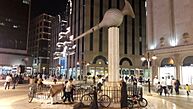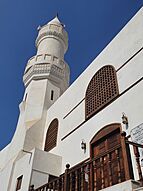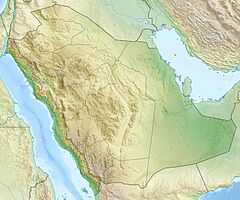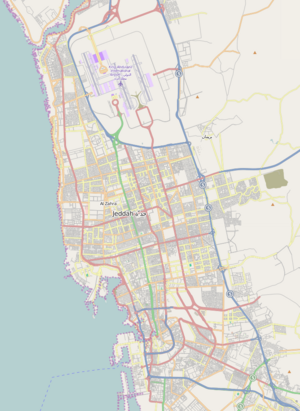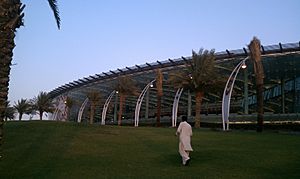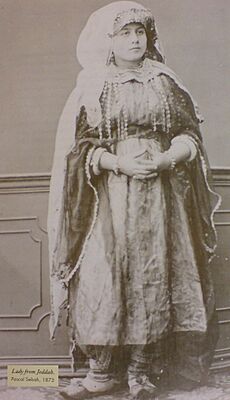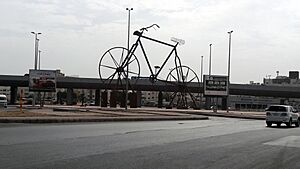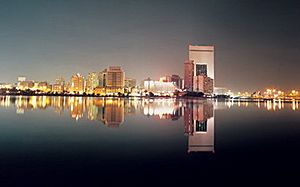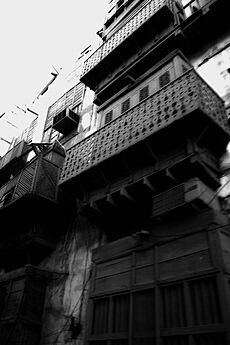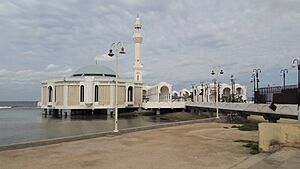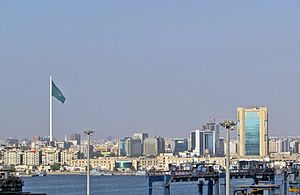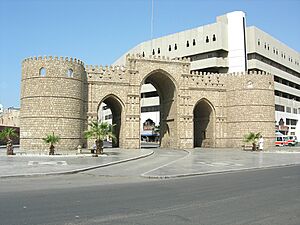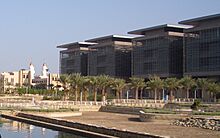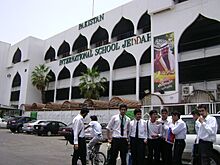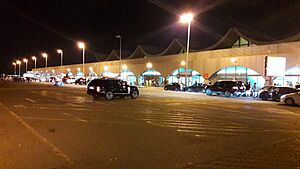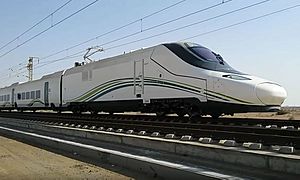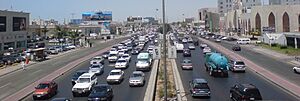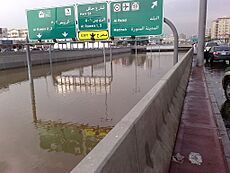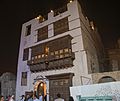Jeddah facts for kids
Quick facts for kids
Jeddah
جِدَّة
|
||
|---|---|---|
|
Jeddah Corniche
Traditional architecture in Historic Jeddah
Historic Jeddah City Center
King Fahd's Fountain
Al-Mimar Mosque
Nasseef House
|
||
|
||
| Nickname(s):
The Bride of the Red Sea
|
||
| Motto(s):
Jeddah Is Different
|
||
| Country | ||
| Region | Mecca | |
| Established | 6th century BC | |
| Area | ||
| • City | 1,600 km2 (600 sq mi) | |
| • Urban | 1,793 km2 (692 sq mi) | |
| • Metro | 2,485 km2 (959 sq mi) | |
| Elevation | 12 m (39 ft) | |
| Population
(2022)
|
||
| • City | 3,751,722 | |
| • Density | 2,340/km2 (6,070/sq mi) | |
| GDP (PPP) | ||
| • Year | 2023 | |
| • Total | $235.6 billion | |
| • Per capita | $48,500 | |
| Time zone | UTC+3 (Arabia Standard Time) | |
| Postal Code |
5 digit codes beginning with 21 (e.g. 21577)
|
|
| Area code(s) | +966 12 | |
| HDI (2021) | 0.871 – very high | |
| UNESCO World Heritage Site | ||
| Official name | Historic Jeddah, the Gate to Makkah | |
| Criteria | Cultural: ii, iv, vi | |
| Inscription | 2014 (38th Session) | |
| Area | 17.92 ha | |
| Buffer zone | 113.58 ha | |
Jeddah is a big port city in Saudi Arabia. It is located along the Red Sea coast. Jeddah is known as the country's main business hub.
The city became very important in 647 AD. This was when the leader Uthman made it a travel center. It helped Muslim travelers going to the holy city of Mecca for their Islamic pilgrimage. Since then, Jeddah has been the main entry point for millions of pilgrims. They arrive by sea or by air at King Abdulaziz International Airport.
Jeddah is the largest city in the Makkah Province. It is also the second-largest city in Saudi Arabia, after the capital Riyadh. About 3.7 million people lived there in 2022. The city is also the administrative center for the OIC. Jeddah Islamic Port is one of the busiest seaports in the Middle East.
Jeddah is the main gateway to Mecca, which is the holiest city in Islam. Mecca is about 65 kilometers (40 miles) to the east. Medina, the second holiest city, is 360 kilometers (224 miles) to the north. Jeddah is working to grow its investments in science and engineering. It was named a "Beta world city" by a global study group. The city's food culture is special because it's close to the Red Sea. Fishing and seafood are very popular. The city's motto in Arabic is "Jeddah Ghair," which means "Jeddah is different."
Contents
- About the Name of Jeddah
- Jeddah's Past: A Brief History
- Jeddah's Location and Weather
- Jeddah's Economy and Shopping
- Jeddah's Culture and Lifestyle
- Jeddah's Cityscape and Landmarks
- Main Sights to See in Jeddah
- Education in Jeddah
- Sports in Jeddah
- Getting Around Jeddah
- Challenges in Jeddah
- Districts of Jeddah
- Sister Cities of Jeddah
- Images for kids
- See also
About the Name of Jeddah
The name Jeddah has a few possible origins. A common story says it comes from the Arabic word Jaddah, meaning "grandmother." People believe that the Tomb of Eve, who is seen as the grandmother of humanity, is located in Jeddah.
The traveler Ibn Battuta visited Jeddah around 1330. He wrote the city's name as "Jiddah" in his diary. Today, the official Saudi maps use the spelling "Jeddah." This is the most common way to spell it now.
Jeddah's Past: A Brief History
Jeddah has a long history. Some old writings found nearby show that people lived in the area a very long time ago. Some think Jeddah was settled by fishermen even before Alexander the Great explored the Red Sea. The Ministry of Hajj says Jeddah has been a home for people for over 2500 years.
Archaeologists believe Jeddah started as a small fishing village. It was founded by the Quda'a tribe from Yemen. They moved there after a dam broke in Yemen around 115 BC.
Jeddah as a Port City
Jeddah became important around 647 AD. The third Muslim leader, Uthman Ibn Affan, made it the main port for Mecca. This helped pilgrims travel to the holy city.
Over the centuries, different empires ruled Jeddah. These included the Umayyads and the Abbasids. Jeddah remained a key harbor for fishermen and pilgrims. Later, the Fatimids and Ayyubids also controlled the city. They helped Jeddah become a busy trading center. Sailors and merchants from places like India, Southeast Asia, and East Africa came to Jeddah.
In 1258, Jeddah became part of the Mamluk Sultanate. When Portuguese explorers started sailing in the Indian Ocean, they attacked ships carrying goods and pilgrims. To protect the city, Jeddah was fortified with a wall. This wall was built using forced labor.
Ottoman Rule and Saudi Control
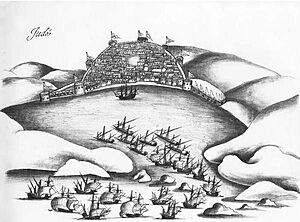
In 1517, the Ottoman Turks took control of Jeddah. They rebuilt the city's walls in 1525 to defend against Portuguese attacks. The new stone wall had six watchtowers and six gates. Some parts of these old city walls can still be seen today.
In 1802, forces from the First Saudi State took over Mecca and Jeddah. But Muhammad Ali Pasha from Egypt soon recaptured the city in 1813.
Modern Jeddah
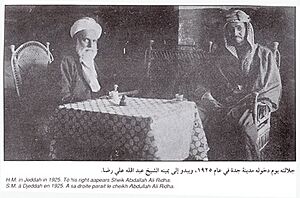
During World War I, the leader Hussein bin Ali declared independence from the Ottoman Empire. He created the Kingdom of Hejaz. Later, Ibn Saud conquered Jeddah in 1925. Jeddah then became part of the Al-Saud dynasty.
The old city walls were taken down in 1947. A fire in 1982 damaged some old buildings in Al-Balad, the historic center. However, many historic buildings are still preserved. A special department was created in 1990 to protect Jeddah's historical area.
The modern city has grown a lot. It has expanded north along the Red Sea coast. In 2021, Saudi authorities began a large project to redevelop parts of southern Jeddah. This project is part of Saudi Vision 2030.
Jeddah's Location and Weather
Jeddah is located on Saudi Arabia's Red Sea coast. It is part of the Tihamah region, near the lower Hijaz mountains. Jeddah is the 100th largest city in the world by land area.
Jeddah's Climate
Jeddah has a very hot and dry climate. Winters are warm, with temperatures from 15°C (59°F) in the morning to 28°C (82°F) in the afternoon. Summers are extremely hot, often going above 40°C (104°F). Summers can also be very humid.
Rainfall is usually light and happens in November and December. Heavy thunderstorms can occur in winter. Dust storms are common in summer and sometimes in winter. These storms bring dust from the deserts of the Arabian Peninsula or North Africa.
| Climate data for Jeddah (1991–2020) | |||||||||||||
|---|---|---|---|---|---|---|---|---|---|---|---|---|---|
| Month | Jan | Feb | Mar | Apr | May | Jun | Jul | Aug | Sep | Oct | Nov | Dec | Year |
| Record high °C (°F) | 36.0 (96.8) |
37.4 (99.3) |
40.6 (105.1) |
44.5 (112.1) |
48.2 (118.8) |
52.0 (125.6) |
47.0 (116.6) |
49.4 (120.9) |
48.0 (118.4) |
46.4 (115.5) |
40.0 (104.0) |
37.0 (98.6) |
52.0 (125.6) |
| Mean daily maximum °C (°F) | 28.8 (83.8) |
29.8 (85.6) |
31.7 (89.1) |
34.5 (94.1) |
37.1 (98.8) |
38.3 (100.9) |
39.4 (102.9) |
38.7 (101.7) |
37.4 (99.3) |
36.6 (97.9) |
33.3 (91.9) |
30.6 (87.1) |
34.7 (94.5) |
| Daily mean °C (°F) | 23.4 (74.1) |
24.0 (75.2) |
25.5 (77.9) |
28.3 (82.9) |
30.7 (87.3) |
31.8 (89.2) |
33.2 (91.8) |
33.2 (91.8) |
31.9 (89.4) |
30.2 (86.4) |
27.6 (81.7) |
25.2 (77.4) |
28.7 (83.7) |
| Mean daily minimum °C (°F) | 18.8 (65.8) |
19.0 (66.2) |
20.2 (68.4) |
22.8 (73.0) |
25.0 (77.0) |
25.8 (78.4) |
27.6 (81.7) |
28.6 (83.5) |
27.3 (81.1) |
25.0 (77.0) |
22.9 (73.2) |
20.6 (69.1) |
23.6 (74.5) |
| Record low °C (°F) | 11.0 (51.8) |
9.8 (49.6) |
10.0 (50.0) |
12.0 (53.6) |
16.4 (61.5) |
20.0 (68.0) |
20.5 (68.9) |
22.0 (71.6) |
17.0 (62.6) |
15.6 (60.1) |
15.0 (59.0) |
11.4 (52.5) |
9.8 (49.6) |
| Average precipitation mm (inches) | 12.5 (0.49) |
3.4 (0.13) |
2.6 (0.10) |
1.9 (0.07) |
0.1 (0.00) |
0.1 (0.00) |
0.5 (0.02) |
0.6 (0.02) |
0.1 (0.00) |
1.5 (0.06) |
27.1 (1.07) |
9.1 (0.36) |
59.5 (2.32) |
| Average precipitation days (≥ 1.0 mm) | 1.1 | 0.3 | 0.4 | 0.2 | 0.1 | 0.0 | 0.1 | 0.2 | 0.0 | 0.4 | 1.9 | 0.7 | 5.4 |
| Average relative humidity (%) | 60 | 60 | 60 | 57 | 56 | 58 | 53 | 59 | 67 | 66 | 65 | 63 | 60 |
| Source: World Meteorological Organization, Jeddah Regional Climate Center | |||||||||||||
| Jan | Feb | Mar | Apr | May | Jun | Jul | Aug | Sep | Oct | Nov | Dec |
|---|---|---|---|---|---|---|---|---|---|---|---|
| 26.3 °C (79.3 °F) | 25.7 °C (78.3 °F) | 25.8 °C (78.4 °F) | 26.8 °C (80.2 °F) | 28.1 °C (82.6 °F) | 29.0 °C (84.2 °F) | 30.6 °C (87.1 °F) | 31.6 °C (88.9 °F) | 31.1 °C (88.0 °F) | 30.7 °C (87.3 °F) | 29.1 °C (84.4 °F) | 27.9 °C (82.2 °F) |
Jeddah's Economy and Shopping
Jeddah has always been an important port city and trading hub. In the 1800s, goods like mother-of-pearl and spices were shipped from here. Many goods passing through Jeddah were on their way to other places like Africa or Europe.
Jeddah is now the second-largest business center in the Middle East, after Dubai. This is because many major cities in the Middle East and North Africa are only a two-hour flight away. Jeddah also has the fourth-largest industrial area in Saudi Arabia.
Important Streets for Business and Shopping
- King Abdullah Street: This is a very important street in Jeddah. It runs from the waterfront to the eastern part of the city. Many company offices and shops are located here. It is also close to the high-speed train station. This station connects Jeddah to Mecca, Medina, and King Abdullah Economic City. The street also has the world's second-tallest flagpole, which is 170 meters (558 feet) high.
- Tahliyah Street: This street is famous for fashion and shopping. It has many fancy department stores and high-end fashion brands. It also offers many great places to eat.
- Madinah Road: This is a historic street that connects the southern and northern parts of Jeddah. Many company offices and showrooms are on this road. It also leads to the King Abdul Aziz International Airport, which means it can get very busy.
Jeddah's Culture and Lifestyle
Most people in Jeddah are Sunni Muslims. The city has over 1,300 mosques. Since the 600s, Jeddah has welcomed millions of Muslim pilgrims. These visitors from all over the world have greatly influenced Jeddah's society, religion, and economy.
Delicious Food in Jeddah
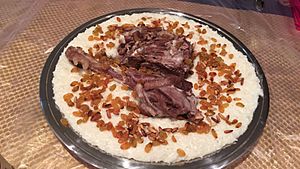
Jeddah's many different cultures have shaped its traditional food. Some dishes are from the Hejaz region, like Saleeg, a white-rice dish often cooked with chicken. Other popular Jeddah dishes include Foul, Shorabah Hareira (Hareira soup), and Madhbi (chicken grilled on stone). You can find these in many traditional restaurants.
Some foods were brought from other parts of Saudi Arabia, like Kabsa from Najd. Other dishes came from different cultures, such as Mantu and Ruz Bukhāri from Central Asia. Mandi is from Yemen, and Biryāni is from South Asia.
The most popular local fast-food chain is Al Baik. It started in 1974 and is famous for its broasted chicken and seafood.
Art in Public Spaces
In the 1970s and 1980s, the city's mayor, Mohamed Said Farsi, worked to bring art to Jeddah's public areas. Because of this, Jeddah has many modern outdoor sculptures. You can often see them in roundabouts. These sculptures include works by famous artists like Alexander Calder and Henry Moore. They often show traditional Saudi items like coffee pots or palm trees. Islamic traditions usually avoid showing living creatures, which influences the art.
Museums and Collections
Jeddah has several museums. The Jeddah Regional Museum of Archaeology and Ethnography shows the city's rich Islamic and pre-Islamic history. The Nasseef House is another museum that displays local furniture and designs from the past 150 years.
Events and Festivals
- Red Sea International Film Festival: Jeddah hosts this annual film festival. It started in 2020.
- Jeddah International Book Fair: This is an annual international book fair. It is the second-largest book fair in Saudi Arabia and began in 2015.
- Jeddah Season: This is a big event that aims to boost tourism in Saudi Arabia. It includes many activities and events held in different parts of Jeddah. The first season was in 2019. Jeddah Season wants to make Jeddah a top tourist spot.
Media and Communication
Jeddah has several major Arabic and English newspapers. It is also the largest radio and television market in Saudi Arabia. The Jeddah TV Tower is 250 meters (820 feet) tall and has a viewing deck.
The local way of speaking in Jeddah is called the Hejazi dialect. It is one of the most easily recognized Arabic accents.
Jeddah's Cityscape and Landmarks
| UNESCO World Heritage Site | |
|---|---|
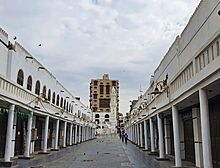
A market street in Old Jeddah with the al-Mimar Mosque in the background.
|
|
| Official name | Historic Jeddah, the Gate to Makkah |
| Criteria | Cultural: (ii), (iv), (vi) |
| Inscription | 2014 (38th Session) |
| Area | 17.92 ha |
Old Jeddah: Al-Balad
The old part of the city is called Al-Balad. It has traditional multi-story buildings and merchant houses. Many of these still belong to the families who lived there before the oil boom. In 2014, Al-Balad became a UNESCO World Heritage Site. Since then, many old buildings have been restored and opened to the public. In 2019, the Saudi Crown Prince ordered the restoration of 50 historic buildings in Jeddah.
Al-Balad also has several old mosques and one of the oldest museums, Bayt Naseef. The old city was once surrounded by a defensive wall. Inside, it was divided into districts called Haras. Business happened in traditional souks (markets) and khans (covered markets).
Famous Districts in Old Jeddah
- Harrat Al-Mathloum: This district is in the northeast. It has landmarks like Dar Al-Qabil and the Al-Shafi'i mosque, which has a minaret from the 13th century.
- Harrat Al-Sham: Located in the north, this district includes Dar Al-Sadat and the Al-Basha Mosque, built in 1735.
- Harrat Al-Yemen: In the south, this district is home to Bait Nasseef. This famous building was built in 1881 and was once the royal home of King Abdulaziz.
- Harrat Al-Bahar: This district is in the southwest, near the sea.
Resorts and Hotels
Jeddah has many popular resorts along the Red Sea. Many are known for their beautiful marine life and coral reefs.
Consulates
Jeddah hosts consulates for many countries. This includes the United States, the United Kingdom, India, Pakistan, and China.
Main Sights to See in Jeddah
Abdul Raouf Khalil Museum
This museum was founded in 1996. It shows the rich Islamic culture of Jeddah. It also covers the city's history from 2500 years ago. The museum has many items from the Ottoman Turks and the early fishing tribes.
King Fahd's Fountain
Built in the 1980s, King Fahd's Fountain is the tallest water jet in the world. It sprays water up to 312 meters (1,024 feet) high. You can see it from far away. The fountain was a gift to Jeddah from the late King Fahd bin Abdul Aziz.
Al-Rahmah Mosque
This mosque is sometimes called the "floating mosque" because it is built over the water. It was built in 1985 and combines old and new architectural styles. It's a popular place for both tourists and locals.
King Abdullah Sports City
King Abdullah Sports City is a large stadium mainly used for football. It opened in 2014 and can hold over 62,000 people. It is the second-largest stadium in Saudi Arabia.
King Saud Mosque
Built in 1987, King Saud Mosque is the largest mosque in Jeddah. It features beautiful Islamic architecture.
Jeddah Tower
The Jeddah Tower is a proposed skyscraper that will be the tallest building in the world when finished. It is planned to be about 1 kilometer (0.6 miles) tall. Construction started in 2013 and is expected to be completed in 2029.
Jeddah Flagpole
The Jeddah Flagpole was once the tallest flagpole in the world. It is 171 meters (561 feet) high. The Saudi flag on top weighs 570 kilograms (1,257 pounds). It was first raised on Saudi Arabia's National Day in 2014.
Entrance of Mecca (Quran Gate)
The Makkah Gate, also called the "Quran Gate," is located about 60 kilometers (37 miles) outside Jeddah. It marks the entrance to Mecca, the birthplace of Muhammad. Non-Muslims are not allowed to enter the holy area beyond this gate. The gate was designed in 1979 and looks like a book (the Quran) on a book stand.
Jeddah Waterfront
The new Jeddah Waterfront opened in 2017. It stretches for 30 square kilometers (11.6 square miles) along the Red Sea. It has many facilities like swimming beaches, restaurants, parks, and dancing fountains.
Education in Jeddah
As of 2005, Jeddah had many public and private schools for boys and girls. Most schools teach in Arabic, but English is also very important. Some private schools teach in English.
Jeddah is home to several universities and colleges, including:
- King Saud bin Abdulaziz University for Health Sciences
- King Abdulaziz University
- King Abdullah University of Science and Technology
- University of Jeddah
- Arab Open University
- Dar Al-Hekma College
- Effat University
- University of Business and Technology (UBT)
- Teacher's College
- Jeddah College of Technology
- Jeddah Private College
- College of Health Care
- College of Telecom & Electronics
- College of Community
- Private College of Business
- Ibn Sina National College for Medical Studies
- Batterjee Medical College
- Prince Sultan College of Tourism
- Prince Sultan Aviation Academy
- Islamic Fiqh Academy
- Jeddah Institute for Speech and Hearing
- Saudi German Institute for Nursing
There are also many primary, middle, and high schools, such as:
- Jeddah Knowledge International School
- American International School of Jeddah
- Italian international school
- Jeddah International School
- Zahrat Al-Sahraa International school (ZSIS)
- Cedar International School
- British International School of Jeddah (Continental, BISJ)
- German International School Jeddah
- Al-Thager Model School
- International Indian School Jeddah (IISJ)
- Pakistan International School Jeddah (PISJ)
- Talal International School Jeddah (TISJ)
- DPS Jeddah Al-Falah International School
- International Philippine School in Jeddah
- Jeddah Japanese School
- Korean International School of Jeddah (KISJ; 젯다한국국제학교)
- Al-Waha International School
- Beladi International School Jeddah
- Al-Afaq International School
- Manarat Jeddah Schools
- Gharnatah International School
- New Al Wurood International School Jeddah [NAWIS]
- Bangladesh International School Jeddah (BISESJ)
- Bader International School
- Arab international school
- Nobles International School (NIS)
- Dauha Al Uloom International School (DAUISJ)
- Al-Fath Schools
- Al-Aqsa Private Schools
- Dar Al-Fikr Schools (DAF)
- Al-Fanar School Jeddah
- Dar Al-Thikr Schools
- Hala International School (HIS)
- Jeddah International Turkish School (JITS)
- Jeddah Prep and Grammar School (JPGS)
- Al Hamraa Girls' School
- Building Blocks (private school)
- Dar Jana International School (DJIS)
- Al Mawarid International School Jeddah [AMIS]
- Pioneer International School
- Duaa International School Jeddah (DISJ)
- Jeddah Private School (JPS)
- Nhaond School
- Number 18 High School
- Number 25 Secondary School
- Tuletelah High School
- Bangladesh International School And College (Bangla Section) Jeddah (BISCJ)
- Al-Afkar International School
- Waad Academy School
- Al Kon International School
Libraries in Jeddah
The main library at King Abdulaziz University has a large collection of books. It is open to the public. The King Abdul Aziz Public Library focuses on Islamic and Arabic history. It has separate sections for men, women, and children.
Sports in Jeddah
Jeddah is home to two big football clubs: Al-Ittihad Club and Al-Ahli Saudi FC. Both teams play at King Abdullah Stadium. Jeddah also hosted the 2023 FIFA Club World Cup.
The city has a basketball team, Al-Ittihad Jeddah, which won the Saudi Arabian championship in 2015.
Jeddah also hosts the Saudi Arabian Grand Prix, a Formula 1 car race. The race takes place on the Jeddah Corniche Circuit, a street track along the Red Sea. The first race was held in 2021.
Getting Around Jeddah
Airport
Jeddah is served by King Abdulaziz International Airport. It has special terminals for pilgrims during the Hajj season. There is also a Royal Terminal for VIPs and the Saudi royal family.
Seaport
Jeddah Seaport is a very busy seaport. It handles most of Saudi Arabia's commercial goods. It is also part of the "21st Century Maritime Silk Road," a major trade route.
Roads and Rail
Highway 40 connects Jeddah to Mecca, Riyadh, and Dammam. Jeddah does not have a subway system yet, but the Haramain High Speed Rail Project connects it to Mecca and Medina. There are plans to build a light metro system in the city.
Challenges in Jeddah
Jeddah faces some challenges, including pollution, traffic, and issues with its water systems.
Pollution and Environment
Air pollution can be a problem in Jeddah, especially on hot days. The city also has pollution from industrial areas and the seaport. However, much of the seafront is considered safe and clean.
Traffic
Roads in Jeddah can get very crowded, especially during holidays. Most adults in Jeddah own at least one car, and there isn't much public transportation. The city is working on plans to build more bridges and underpasses to help with traffic.
Floods
Jeddah has experienced heavy floods, especially in 2009, 2011, 2015, 2017, and 2022. These floods have caused damage to cars and buildings. The city has been working to improve its storm drainage system to prevent future floods.
Districts of Jeddah
Jeddah is made up of 137 districts. Some of these include:
- Al-Murjan (The Coral)
- Al-Basateen (The Orchards)
- Al-Mohamadiya (Of Mohammed)
- Ash-Shati (The Beach)
- An-Nahda (The Renaissance)
- An-Naeem (The Bliss)
- An-Nuzha (The Excursion)
- Az-Zahraa (from Fatima Az-Zahraa)
- As-Salamah (The Safety)
- Al-Bawadi
- Ar-Rabwa (The Hill)
- Al-Safa
- Al-Khalidiya (Of Khalid)
- Ar-Rawdha (The Medow)
- Al-Faysaliya (Of Faisal)
- Al-Andalus (Andalucia)
- Al-Aziziya (Of Aziz "Abdulaziz")
- Ar-Rihab (The Vast Expanse)
- Al-Hamraa (The Red or Alhambra)
- Mosharafa
- Ar-Ruwais
- Ash-Sharafiya (Of The Shareef)
- Bani Malik
- Al-Woroud (The Flowers)
- An-Naseem (The Breeze)
- Al-Baghdadiya Ash-Sharqiya (Of East Baghdad)
- Al-Amariya (Of Ammar)
- Al-Hindawiya
- As-Saheifa
- Al-Kandra
- As-Sulaimaniya (Of Sulaiman/Solomon)
- Al-Thaalba (The Foxes)
- As-Sabeel (The Path)
- Al-Qurayat
- Gholail
- An-Nozla Al-Yamaniya
- Al-Nozla Ash-Sharqiya
- Al-Taghr (The Stoma)
- Al-Jamaa (The University; due to its proximity to King Abdulaziz University)
- Madayin Al-Fahad (The Cities of Fahad)
- Ar-Rawabi
- Al-Wazeeriya (The Ministerial)
- Petromin
- Al-Mahjar (The Stone Pit)
- Prince Abdel Majeed
- Obhour Al-Janobiya (South of the Obhur Bay)
- Al-Marwa
- AL-Fayhaa
- King Abdul Al-Aziz University
- Al-Baghdadiya Al-Gharbiya (Of West Baghdad)
- Al-Balad (The City)
- Al-Ajwad
- Al-Manar
- As-Samer
- Abruq Ar-Roghama
- Madinat As-Sultan
- Um Hablain
- Al-Hamdaniya
- Al-Salhiya
- Mokhatat Al-Aziziya
- Mokhatat Shamal Al-Matar
- Mokhatat Ar-Riyadh
- Mokhatat Al-Huda
- Braiman
- Al-Salam
- Al-Mostawdaat
- Al-Montazahat
- Kilo 14
- Al-Harazat
- Um As-Salam
- Mokhtat Zahrat Ash-Shamal
- Al-Majid
- Gowieza
- Al-Gozain
- Al-Kuwait
- Al-Mahrogat
- Al-Masfa
- Al-Matar Al-Gadeem (old airport)
- Al-Bokhariya
- An-Nour
- Bab Shareif
- Bab Makkah
- Bahra
- Al-Amir Fawaz
- Wadi Fatma
- Obhour Shamaliya
- At-Tarhil (deportation)
- Al-Iskan Al-janoubi
- At-Tawfeeq
- Al-Goaid
- Al-Jawhara
- Al-Jamoum
- Al-Khumra
- Ad-Difaa Al-Jawi (Air Defense)
- Ad-Dageeg
- Ar-Robou
- Ar-Rabie
- Ar-Rehaily
- As-Salmiya
- As-Sanabil
- As-Sinaiya (Bawadi)
- Industrial City (Mahjar)
- Al-Adl
- Al-Olayia
- Al-Faihaa
- Al-Karanteena
- Al-Ajaweed
- Al-Ahmadiya
- Al-Mosadiya
- East Al-Khat As-Sarei
- Kilo 10
- King Faisal Navy Base
- Kilo 7
- Kilo 45
- King Faisal Guard City
- Kilo 11
- Thowal
- Kilo 13
- Al-Makarona
- Al-Layth
- Al-Gonfoda
- Rabegh
- Kilo 8
- Kilo 5
- Kilo 2
- Al-Mokhwa
- National Guard Residence
- As-Showag
- Air Defense Residence
- Al-Morsalat
- Ash-Shoola
- Al-Corniche
- Al-Waha
- Mokhatat Al-Haramain
- Kholais
- Al-Rhmanya
- Wadi al batin
- AL MADINAH
- JUDAYYIADAT ARAR
- AS SALWA
- al huda
Sister Cities of Jeddah
Jeddah is connected with many cities around the world. These are called "sister cities."
 Adana, Turkey
Adana, Turkey Alexandria, Egypt
Alexandria, Egypt Almaty, Kazakhstan
Almaty, Kazakhstan Amman, Jordan
Amman, Jordan Baku, Azerbaijan
Baku, Azerbaijan Chittagong, Bangladesh
Chittagong, Bangladesh Dubai, United Arab Emirates
Dubai, United Arab Emirates Istanbul, Turkey
Istanbul, Turkey Jakarta, Indonesia
Jakarta, Indonesia Karachi, Pakistan
Karachi, Pakistan Kuching, Malaysia
Kuching, Malaysia Marbella, Spain
Marbella, Spain Mary, Turkmenistan
Mary, Turkmenistan Oran, Algeria
Oran, Algeria Osh, Kyrgyzstan
Osh, Kyrgyzstan Plovdiv, Bulgaria
Plovdiv, Bulgaria Surabaya, Indonesia
Surabaya, Indonesia Taipei, Taiwan
Taipei, Taiwan Tunis, Tunisia
Tunis, Tunisia
Images for kids
-
Mohammed Abu Zenada, an advisor to the Sharif during the surrender to King Abdulaziz Ibn Saud in 1925.
See also
 In Spanish: Yeda para niños
In Spanish: Yeda para niños




